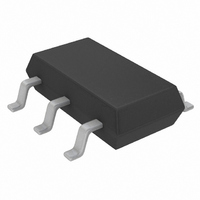LTC1772CS6#TR Linear Technology, LTC1772CS6#TR Datasheet - Page 9

LTC1772CS6#TR
Manufacturer Part Number
LTC1772CS6#TR
Description
IC CTRLR DC/DC STEPDOWN SOT23-6
Manufacturer
Linear Technology
Type
Step-Down (Buck)r
Datasheet
1.LTC1772ES6TRMPBF.pdf
(12 pages)
Specifications of LTC1772CS6#TR
Internal Switch(s)
No
Synchronous Rectifier
No
Number Of Outputs
1
Voltage - Output
0.8 ~ 9.8 V
Current - Output
1A
Frequency - Switching
550kHz
Voltage - Input
2.5 ~ 9.8 V
Operating Temperature
0°C ~ 70°C
Mounting Type
Surface Mount
Package / Case
TSOT-23-6, TSOT-6
Lead Free Status / RoHS Status
Contains lead / RoHS non-compliant
Power - Output
-
Available stocks
Company
Part Number
Manufacturer
Quantity
Price
APPLICATIONS
Low Supply Operation
Although the LTC1772 can function down to approxi-
mately 2V, the maximum allowable output current is
reduced when V
amount of change as the supply is reduced down to 2V.
Also shown in Figure 3 is the effect of V
goes below 2.3V.
Setting Output Voltage
The LTC1772 develops a 0.8V reference voltage between
the feedback (Pin 3) terminal and ground (see Figure 4). By
selecting resistor R1, a constant current is caused to flow
through R1 and R2 to set the overall output voltage. The
regulated output voltage is determined by:
For most applications, an 80k resistor is suggested for R1.
To prevent stray pickup, locate resistors R1 and R2 close
to LTC1772.
V
OUT
=
Figure 3. Line Regulation of V
105
100
95
90
85
80
75
0 8 1
2.0
.
Figure 4. Setting Output Voltage
⎛
⎜
⎝
LTC1772
IN
+
decreases below 3V. Figure 3 shows the
2.2
V
U
R
R
FB
2
1
INPUT VOLTAGE (V)
⎞
⎟
⎠
3
V
V
2.4
INFORMATION
REF
ITH
U
2.6
R2
R1
W
2.8
REF
and V
IN
1772 F03
1772 F04
V
OUT
on V
3.0
ITH
U
REF
as V
IN
Efficiency Considerations
The efficiency of a switching regulator is equal to the
output power divided by the input power times 100%. It is
often useful to analyze individual losses to determine what
is limiting the efficiency and which change would produce
the most improvement. Efficiency can be expressed as:
where η1, η2, etc. are the individual losses as a percent-
age of input power.
Although all dissipative elements in the circuit produce
losses, four main sources usually account for most of the
losses in LTC1772 circuits: 1) LTC1772 DC bias current,
2) MOSFET gate charge current, 3) I
voltage drop of the output diode.
1. The V
2. MOSFET gate charge current results from switching
3. I
4. The output diode is a major source of power loss at
Efficiency = 100% – (η1 + η2 + η3 + ...)
electrical characteristics, that excludes MOSFET driver
and control currents. V
which increases with V
the gate capacitance of the power MOSFET. Each time
a MOSFET gate is switched from low to high to low
again, a packet of charge dQ moves from V
The resulting dQ/dt is a current out of V
typically much larger than the DC supply current. In
continuous mode, I
MOSFET, inductor and current shunt. In continuous
mode the average output current flows through L but
is “chopped” between the P-channel MOSFET (in se-
ries with R
R
summed with the resistances of L and R
I
high currents and gets worse at high input voltages.
The diode loss is calculated by multiplying the forward
voltage times the diode duty cycle multiplied by the
load current. For example, assuming a duty cycle of
50% with a Schottky diode forward voltage drop of
2
2
DS(ON)
R losses are predicted from the DC resistances of the
R losses.
IN
current is the DC supply current, given in the
plus R
SENSE)
SENSE
and the output diode. The MOSFET
GATECHG
multiplied by duty cycle can be
IN
IN
current results in a small loss
.
= f(Qp).
2
R losses and 4)
LTC1772
SENSE
IN
IN
to ground.
to obtain
which is
1772fb
9













